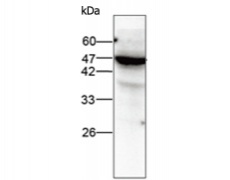|
Background: |
The 26S proteasome is a multicatalytic proteinase complex with a highly ordered structure composed of 2 complexes, a 20S core and a 19S regulator. The 20S core is composed of 4 rings of 28 non-identical subunits; 2 rings are composed of 7 alpha subunits and 2 rings are composed of 7 beta subunits. The 19S regulator is composed of a base, which contains 6 ATPase subunits and 2 non-ATPase subunits, and a lid, which contains up to 10 non-ATPase subunits. Proteasomes are distributed throughout eukaryotic cells at a high concentration and cleave peptides in an ATP/ubiquitin-dependent process in a non-lysosomal pathway. An essential function of a modified proteasome, the immunoproteasome, is the processing of class I MHC peptides. This gene encodes one of the ATPase subunits, a member of the triple-A family of ATPases which have a chaperone-like activity. This subunit has been shown to interact with several of the basal transcription factors so, in addition to participation in proteasome functions, this subunit may participate in the regulation of transcription. This subunit may also compete with PSMC3 for binding to the HIV tat protein to regulate the interaction between the viral protein and the transcription complex. Alternative splicing results in multiple transcript variants encoding distinct isoforms. |
|
Applications: |
ELISA, WB |
|
Name of antibody: |
PSMC2 |
|
Immunogen: |
Fusion protein of human PSMC2 |
|
Full name: |
proteasome 26S subunit, ATPase 2 |
|
Synonyms: |
S7; MSS1; Nbla10058 |
|
SwissProt: |
P35998 |
|
WB Predicted band size: |
49 kDa |
|
WB Positive control: |
HeLa whole cell lysate |
|
WB Recommended dilution: |
1000-5000 |

 購物車
購物車 幫助
幫助
 021-54845833/15800441009
021-54845833/15800441009
